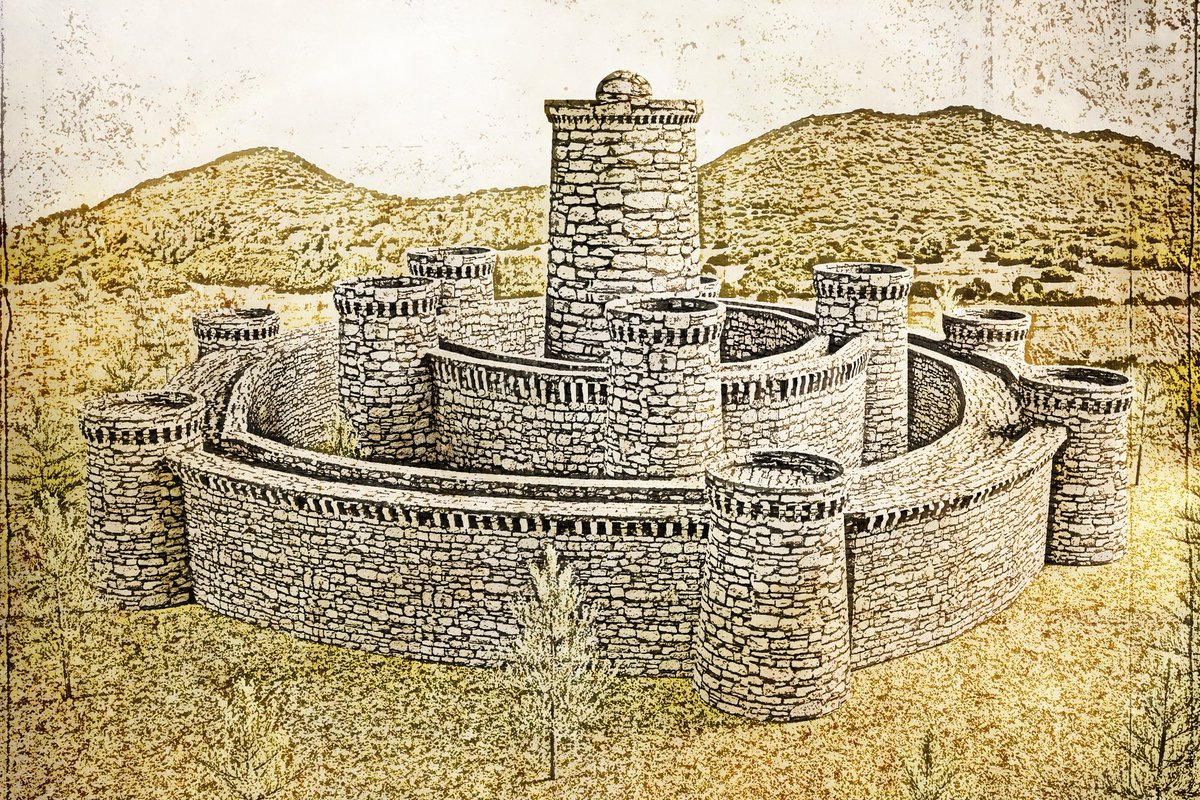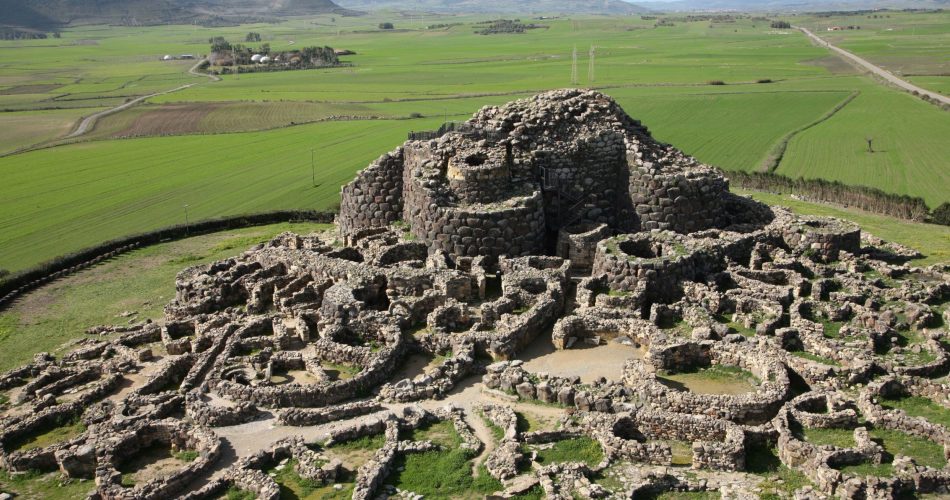
**NURAGIC SARDINIA – part 1: the culture**
Thread about the most peculiar Sardinian culture, lasting several millennia and still largely unknown.
📸 Modern representation of a nuraghe
Thread about the most peculiar Sardinian culture, lasting several millennia and still largely unknown.
📸 Modern representation of a nuraghe

▪️ Timeline. The Nuragic period covers a millennium and a half and roughly divided in:
Nuragic I 1800-1450 BCE (Bronze Age)
Nuragic II 1450-1200 BCE
Nuragic III 1200-900 BCE
Nuragic IV 900-500 BCE (Iron Age)
Nuragic V 500-200 BCE (interaction with Punics)
Nuragic I 1800-1450 BCE (Bronze Age)
Nuragic II 1450-1200 BCE
Nuragic III 1200-900 BCE
Nuragic IV 900-500 BCE (Iron Age)
Nuragic V 500-200 BCE (interaction with Punics)
▪️The name. We don't know for sure how the Nuragic people called themselves. The first mention of the inhabitants/island comes from the stele of Nora, written in Phoenician, and says SHRDN.
Nuragic derives instead from Nuraghes, the name of the most characteristic construction.
Nuragic derives instead from Nuraghes, the name of the most characteristic construction.
▪️Nuraghes. Even in this case, the origin is not certain. The most accepted version sees in nur (bunch of rocks) the origin of the name.
Nuraghes come in different forms, shapes and uses and will have their own thread. They are the castles of the Nuragic Era, made of dry walls.
Nuraghes come in different forms, shapes and uses and will have their own thread. They are the castles of the Nuragic Era, made of dry walls.

▪️ The tribes. There were likely many different civilisations, with slightly different languages, traditions and customs, deriving from a common background. Roman sources of later centuries name some of them: the Balari, the Iliensens and the Sardi Pelliti (furred Sardinians).
▪️The cult. Ancient Sardinians worshipped the Mother Goddess but also a male deity, now commonly known by the Roman name Sardus Pater, Babay in Sardinian. There were likely smaller silvan deities and the cult of water permeated the whole Island, with sacred wells everywhere. 



▪️The women. Also linked to the cult of the Mother Goddess, we see women in important roles such as priestesses. Some decorations in menhirs led historians to think of a matrilineal inheritance of the royal title, characteristic that we find again in Middle Age. 



▪️ The politics. The construction of huge buildings (the nuraghes) with comparison to smaller houses for the commoners, made people think of a monarchic/tribal organisation, with a king or prince ruling over a small group of people and guaranteeing their safety. 

▪️ The village. In the later periods of the Nuragic Age, we see great numbers of smaller houses built around nuraghes, in form of a village of around 100 people.
▪️ The food, wine. It's from these houses that we can have an idea of what they ate. It was mostly derivatives of-
▪️ The food, wine. It's from these houses that we can have an idea of what they ate. It was mostly derivatives of-
-wheat, bread, lentils, olives and fruits. We also know they made wine, both red and white, which makes them one of the first civilisations to cultivate grapes in the western Mediterranean. The white wine (vernaccia) of Oristano might just be that old!
▪️ The language. It's commonly called proto-Sardinian or paleo-Sardinian and only few words still remain today, like babay. This is because we don't have any (certain) written texts. This is a hot topic because many Sardinian academics actually believe the signs in Nuragic- 

-artifacts are signs of a written language and they're studying them, constructing an alphabet with different influences and in ideograms, similar to the way Egyptian hieroglyphs work.
▪️ Bronze statuettes. Ancient Sardinians were masters in the treatment of metals, especially bronze. They made an infinite quantity of statuettes, portraying soldiers, women, animals and ships. These are considered ex-voto to the deity since they have been found in sacred sites. 







▪️ The ships. Sardinians had ships, the statuettes show them. They were likely used as lanterns but the great amount of trades hints at an actual use of ships. They have been recently reconstructed and verified they can really take the sea. 





▪️ Commercial trading. Nuragic artifacts have been found in many parts of the Mediterranean, both western and eastern. Nuragic ceramics have been found in Sicily, Crete, Cyprus, Malta. In turn, Cypriot metals have been thoroughly found in Sardinia, the greatest amount in the -
-western Mediterranean. Moreover, Sardinian metals and obsidian have been found in several places of the Mediterranean coasts, putting Sardinians at the centre of many commercial routes.
▪️ Military adventures. Great part of the Nuragic bronzettes portray warriors. This led people to think of Sardinians as warring against each other and with a vocation for piracy. This comes also from the identification of Sardinians with the Shardana, one of the Sea Peoples.
▪️Shardana. The similarity of the name but also of the weapons and armour, are summed up in this thread by the words of G. Ugas, one of the most important Sardinian archaeologists. ⬇️
In some Egyptian universities is already taught as fact.
In some Egyptian universities is already taught as fact.
https://twitter.com/DrWatson_writer/status/1302567889661198336?s=19
▪️ The statues. When the nuraghes stopped being built, the Sardinians started worshipping them and their ancestors. It's from this period the realisation of the oldest all-round statues of Europe, older than the Greek's. ⬇️⬇️⬇️
https://twitter.com/DrWatson_writer/status/1309798361915158529?s=19
▪️ The end. There's large debate on the matter. Many nuraghes have been found completely covered in mud, all of them suffered from some destruction. It's thought this happened because of some inner rivalry, between tribes or within the same tribe. In fact after this, the-
-political organisation changed: there were no more kings or princes but councils of the powerful of the village (which gives resemblance to the medieval Corona de Logu). Nuraghes weren't built anymore but worshipped. People created villages around them.
It's not clear how much-
It's not clear how much-
-external forces influenced in the fall of the culture, especially Carthaginian forces. Still the Nuragic Age carries on at least until the Roman conquest (215BCE) and for some it retained some characteristics until Early Middle Age.
• • •
Missing some Tweet in this thread? You can try to
force a refresh































